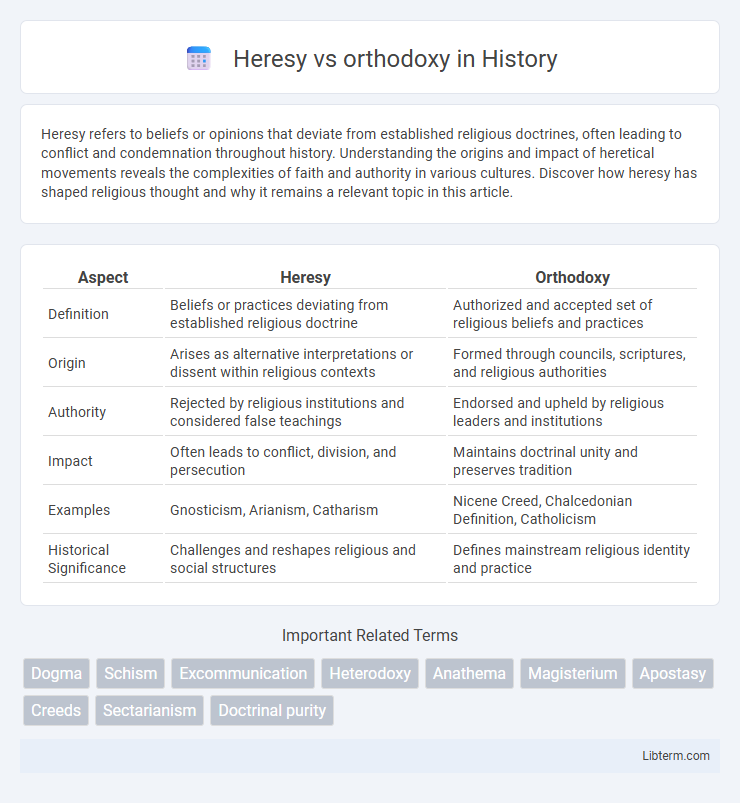Heresy refers to beliefs or opinions that deviate from established religious doctrines, often leading to conflict and condemnation throughout history. Understanding the origins and impact of heretical movements reveals the complexities of faith and authority in various cultures. Discover how heresy has shaped religious thought and why it remains a relevant topic in this article.
Table of Comparison
| Aspect | Heresy | Orthodoxy |
|---|---|---|
| Definition | Beliefs or practices deviating from established religious doctrine | Authorized and accepted set of religious beliefs and practices |
| Origin | Arises as alternative interpretations or dissent within religious contexts | Formed through councils, scriptures, and religious authorities |
| Authority | Rejected by religious institutions and considered false teachings | Endorsed and upheld by religious leaders and institutions |
| Impact | Often leads to conflict, division, and persecution | Maintains doctrinal unity and preserves tradition |
| Examples | Gnosticism, Arianism, Catharism | Nicene Creed, Chalcedonian Definition, Catholicism |
| Historical Significance | Challenges and reshapes religious and social structures | Defines mainstream religious identity and practice |
Defining Heresy and Orthodoxy
Heresy is defined as beliefs or doctrines that deviate from established religious teachings and orthodox dogma, often condemned by authoritative religious institutions. Orthodoxy represents the accepted and officially sanctioned beliefs within a faith community, serving as the standard for correct doctrine and practice. The distinction between heresy and orthodoxy is crucial for maintaining theological coherence and religious identity.
Historical Origins of Heresy and Orthodoxy
Heresy and orthodoxy originated in early Christian history as competing interpretations of doctrine, with orthodoxy representing established beliefs endorsed by church councils such as Nicaea in 325 AD, while heresy encompassed dissenting views deemed heretical by ecclesiastical authorities. The Council of Nicaea established foundational creeds that defined orthodox Christianity and condemned Arianism as heresy, setting a precedent for theological boundaries. This historical development shaped the framework for distinguishing correct doctrine from heretical deviation, influencing subsequent religious and political conflicts.
Major Early Heresies in Religious History
Major early heresies, such as Arianism, Gnosticism, and Nestorianism, challenged foundational Christian doctrines on the nature of Christ, the Trinity, and salvation. Arianism denied the full divinity of Jesus Christ, Gnosticism emphasized secret knowledge and a dualistic worldview, and Nestorianism separated Christ's human and divine natures excessively. These heresies prompted the development of orthodox creeds like the Nicene Creed, shaping the theological boundaries of mainstream Christianity.
The Role of Councils in Establishing Orthodoxy
Church councils played a crucial role in defining doctrinal orthodoxy by addressing heresies and establishing authoritative creeds, such as the Nicene Creed formulated at the First Council of Nicaea in 325 AD. These councils gathered bishops to deliberate theological disputes, resulting in universally accepted teachings that distinguished orthodox beliefs from heretical views. The decisions of ecumenical councils became foundational references for doctrinal conformity and ecclesiastical unity throughout Christian history.
Heresy vs Orthodoxy in Christian Theology
Heresy in Christian theology refers to beliefs or doctrines that deviate significantly from the established orthodox teachings upheld by mainstream Christianity, often challenging core doctrines such as the nature of Christ, the Trinity, or salvation. Orthodoxy emphasizes adherence to the creeds and dogmas defined by ecumenical councils, such as the Nicene Creed, which affirm orthodox Christology and Trinitarian theology as essential to Christian faith. The conflict between heresy and orthodoxy shaped early Church history, leading to the formalization of doctrines and the marginalization of divergent theological interpretations.
Social and Political Impacts of Heretical Movements
Heresy challenged established dogmas, often disrupting the cohesion of religious and political institutions by fostering dissent and alternative power structures. Heretical movements such as the Cathars and Lollards incited peasant revolts and weakened centralized authority, prompting harsh crackdowns like the Inquisition to maintain orthodoxy and social order. The tension between heresy and orthodoxy shaped medieval European governance by legitimizing state enforcement of religious conformity, intertwining faith with political control.
Orthodoxy and Authority: Who Decides What’s Right?
Orthodoxy derives its authority from established religious traditions, sacred texts, and institutional leaders who interpret and uphold doctrinal truths. The determination of what is considered "right" often rests with authoritative bodies such as the Church hierarchy, councils, or recognized theologians who maintain continuity with foundational beliefs. This centralized authority ensures doctrinal unity and sets boundaries that distinguish orthodoxy from heresy.
Heresy and Reform: Agents of Change or Threat?
Heresy, often defined as beliefs or practices deviating from established religious doctrines, serves as a significant catalyst for reform within religious institutions by challenging orthodox authority and prompting doctrinal clarification. Reform movements inspired by heretical ideas have historically led to substantial transformations, as seen in the Protestant Reformation, which questioned Catholic orthodoxy and reshaped Christianity. Despite their disruptive nature, heresies stimulate critical theological discourse and institutional adaptation, underscoring their dual role as agents of change and perceived threats.
Modern Perspectives on Heresy and Orthodoxy
Modern perspectives on heresy and orthodoxy emphasize the fluidity of religious beliefs and the social dynamics shaping doctrinal boundaries. Contemporary scholars analyze heresy not only as theological error but also as a site of cultural resistance and identity negotiation within religious communities. Digital media and globalization have further influenced the dissemination and contestation of orthodox and heretical ideas, highlighting the evolving nature of religious authority and interpretation.
Heresy, Orthodoxy, and the Future of Belief Systems
Heresy challenges established religious doctrines by proposing beliefs that deviate from orthodox interpretations, often leading to conflict and reformation within spiritual communities. Orthodoxy serves as the standard framework preserving traditional tenets and practices, maintaining continuity and authority in faith systems. The future of belief systems hinges on the dynamic interplay between heretical ideas and orthodox structures, influencing adaptation, diversification, and the evolution of spirituality worldwide.
Heresy Infographic

 libterm.com
libterm.com